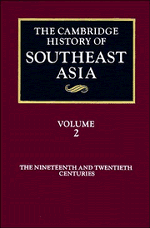Book contents
- Frontmatter
- PART ONE FROM c. 1800 TO THE 1930s
- PART TWO FROM WORLD WAR II TO THE PRESENT
- 6 Southeast Asia in War and Peace: The End of European Colonial Empires
- 7 The Political Structures of the Independent States
- 8 Economic and Social Change
- 9 Religious Change in Contemporary Southeast Asia
- 10 Regionalism and Nationalism
- Bibliographies
- References
6 - Southeast Asia in War and Peace: The End of European Colonial Empires
from PART TWO - FROM WORLD WAR II TO THE PRESENT
Published online by Cambridge University Press: 28 March 2008
- Frontmatter
- PART ONE FROM c. 1800 TO THE 1930s
- PART TWO FROM WORLD WAR II TO THE PRESENT
- 6 Southeast Asia in War and Peace: The End of European Colonial Empires
- 7 The Political Structures of the Independent States
- 8 Economic and Social Change
- 9 Religious Change in Contemporary Southeast Asia
- 10 Regionalism and Nationalism
- Bibliographies
- References
Summary
Writing a history of Southeast Asia as a region presents many challenges: the diversity the region displays in so many fields of human endeavour makes its history exciting but intractable. But if this is true throughout, the period since World War II presents the historian with special problems. By contrast to much of the earlier history, the period is copiously covered in written and printed documents. But they tell only part of the story. The period is, too, relatively recent, so that, in assimilating and analysing the material, it is hard to be sure that the right themes have been chosen. Even determining the date at which to stop is fraught with difficulty. The authors of this part have accepted that their approach must be tentative. At times they must content themselves more with narrative than interpretation.
The period indeed opens with an event the impact of which is still clearly being felt, the Japanese invasion and the collapse of the European empires. This is the subject of Chapter 6. Once more the fortunes of Southeast Asia were profoundly affected by forces outside the region. Once more its peoples reacted in a variety of ways. The colonial regimes were destroyed. In the Japanese phase new social and political opportunities were opened up for some, new constraints placed on others. The economy of the region, damaged in the Great Depression, was profoundly dislocated. Parts of it were fought over, parts not. The attempts of the colonial powers to return were again variously successful. Nationalist movements contended for power. They faced not only returning colonial rulers, but new local rivals. Their success was also partly dependent on the impact of changes outside the region, the decline of British and the rise of US power, the Cold War, the triumph of Chinese communism, the independence of India.
Information
- Type
- Chapter
- Information
- The Cambridge History of Southeast Asia , pp. 325 - 386Publisher: Cambridge University PressPrint publication year: 1993
References
Accessibility standard: Unknown
- 1
- Cited by
